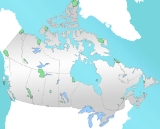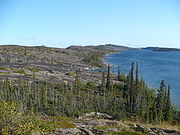
Thaydene Nene National Park
Encyclopedia
Thaydene Nene National Park (from Dene
, meaning land of our ancestors; also East Arm of Great Slave Lake) is a proposed national park located on the northern edge of the boreal forest in the Northwest Territories
, Canada
. It covers an area of approximately 33000 square kilometres (12,741 sq mi).
The area is subject to an interim land withdrawal until 2012, by which "no new mining claims or oil and gas rights will be issued for the area". However, existing industrial and commercial activities will be allowed to continue, as will the construction of any facility associated with Talstom Dam. Designation as a national park would prevent the expansion of uranium
and diamond
mines located just north of the park's boundaries, and protects caribou and pelt
animals such as "lynx
, wolf, red fox
, wolverine
, martin
, moose
and black bear
". It features red granite cliffs, as well as "a spectacular array of peninsulas, canyons and waterfalls as the forests give way to northern tundra". Various migratory bird species also stage and nest in the area, including duck
s and songbird
s.
 Consideration for the creation a national park in the region was withdrawn in 1970 under the Territorial Lands Act, but in 2001 the Lutsel K’e (previously Snowdrift) Dene First Nations
Consideration for the creation a national park in the region was withdrawn in 1970 under the Territorial Lands Act, but in 2001 the Lutsel K’e (previously Snowdrift) Dene First Nations
band re-considered the proposal. Consultations for a feasibility study proceeded from 2002 to 2004, which drew the inclusion of the Métis Nation
in the process. By 2005, the Lutsel K’e produced a Band Council Resolution "supporting consideration of a national park as part of a broader protection initiative for their traditional territory", in cooperation with other Akaitcho
First Nations. In 2006, the Environment Minister Rona Ambrose
signed a Memorandum of Understanding with the Lutsel K’e which expanded the area for consideration for the national park. Originally expected to be designated in 2009, the approval was fast-tracked by the federal government, which allocated $3 million for a final feasibility study for the areas to be protected by the national park, and a further 62000 square kilometres (23,938 sq mi) of adjacent land.
Dene
The Dene are an aboriginal group of First Nations who live in the northern boreal and Arctic regions of Canada. The Dené speak Northern Athabaskan languages. Dene is the common Athabaskan word for "people" . The term "Dene" has two usages...
, meaning land of our ancestors; also East Arm of Great Slave Lake) is a proposed national park located on the northern edge of the boreal forest in the Northwest Territories
Northwest Territories
The Northwest Territories is a federal territory of Canada.Located in northern Canada, the territory borders Canada's two other territories, Yukon to the west and Nunavut to the east, and three provinces: British Columbia to the southwest, and Alberta and Saskatchewan to the south...
, Canada
Canada
Canada is a North American country consisting of ten provinces and three territories. Located in the northern part of the continent, it extends from the Atlantic Ocean in the east to the Pacific Ocean in the west, and northward into the Arctic Ocean...
. It covers an area of approximately 33000 square kilometres (12,741 sq mi).
The area is subject to an interim land withdrawal until 2012, by which "no new mining claims or oil and gas rights will be issued for the area". However, existing industrial and commercial activities will be allowed to continue, as will the construction of any facility associated with Talstom Dam. Designation as a national park would prevent the expansion of uranium
Uranium
Uranium is a silvery-white metallic chemical element in the actinide series of the periodic table, with atomic number 92. It is assigned the chemical symbol U. A uranium atom has 92 protons and 92 electrons, of which 6 are valence electrons...
and diamond
Diamond
In mineralogy, diamond is an allotrope of carbon, where the carbon atoms are arranged in a variation of the face-centered cubic crystal structure called a diamond lattice. Diamond is less stable than graphite, but the conversion rate from diamond to graphite is negligible at ambient conditions...
mines located just north of the park's boundaries, and protects caribou and pelt
Fur
Fur is a synonym for hair, used more in reference to non-human animals, usually mammals; particularly those with extensives body hair coverage. The term is sometimes used to refer to the body hair of an animal as a complete coat, also known as the "pelage". Fur is also used to refer to animal...
animals such as "lynx
Lynx
A lynx is any of the four Lynx genus species of medium-sized wildcats. The name "lynx" originated in Middle English via Latin from Greek word "λύγξ", derived from the Indo-European root "*leuk-", meaning "light, brightness", in reference to the luminescence of its reflective eyes...
, wolf, red fox
Red Fox
The red fox is the largest of the true foxes, as well as being the most geographically spread member of the Carnivora, being distributed across the entire northern hemisphere from the Arctic Circle to North Africa, Central America, and the steppes of Asia...
, wolverine
Wolverine
The wolverine, pronounced , Gulo gulo , also referred to as glutton, carcajou, skunk bear, or quickhatch, is the largest land-dwelling species of the family Mustelidae . It is a stocky and muscular carnivore, more closely resembling a small bear than other mustelids...
, martin
Swallow
The swallows and martins are a group of passerine birds in the family Hirundinidae which are characterised by their adaptation to aerial feeding...
, moose
Moose
The moose or Eurasian elk is the largest extant species in the deer family. Moose are distinguished by the palmate antlers of the males; other members of the family have antlers with a dendritic configuration...
and black bear
American black bear
The American black bear is a medium-sized bear native to North America. It is the continent's smallest and most common bear species. Black bears are omnivores, with their diets varying greatly depending on season and location. They typically live in largely forested areas, but do leave forests in...
". It features red granite cliffs, as well as "a spectacular array of peninsulas, canyons and waterfalls as the forests give way to northern tundra". Various migratory bird species also stage and nest in the area, including duck
Duck
Duck is the common name for a large number of species in the Anatidae family of birds, which also includes swans and geese. The ducks are divided among several subfamilies in the Anatidae family; they do not represent a monophyletic group but a form taxon, since swans and geese are not considered...
s and songbird
Songbird
A songbird is a bird belonging to the suborder Passeri of the perching birds . Another name that is sometimes seen as scientific or vernacular name is Oscines, from Latin oscen, "a songbird"...
s.
History

First Nations
First Nations is a term that collectively refers to various Aboriginal peoples in Canada who are neither Inuit nor Métis. There are currently over 630 recognised First Nations governments or bands spread across Canada, roughly half of which are in the provinces of Ontario and British Columbia. The...
band re-considered the proposal. Consultations for a feasibility study proceeded from 2002 to 2004, which drew the inclusion of the Métis Nation
Métis National Council
The Métis National Council is the representative of the Northwest Métis people within Canada.-History:The National Council was formed in 1983, following the recognition of the Métis as an aboriginal people in Canada, in Section 35 of the Constitution Act, 1982...
in the process. By 2005, the Lutsel K’e produced a Band Council Resolution "supporting consideration of a national park as part of a broader protection initiative for their traditional territory", in cooperation with other Akaitcho
Akaitcho Territory Government
The Akaitcho Territory Government is a First Nations organization representing the Dene people of the Northwest Territories, Canada.-Members:*Deninu Kue First Nation - Fort Resolution*Lutsel K'e Dene First Nation - Lutselk'e...
First Nations. In 2006, the Environment Minister Rona Ambrose
Rona Ambrose
Ronalee "Rona" Ambrose, PC, MP is the Minister of Public Works and Government Services for Canada, Vice-Chair of the Treasury Board Cabinet committee, Minister of State for Status of Women Canada and Minister of Western Economic Diversification.In the previous Parliament, she was Canada's Minister...
signed a Memorandum of Understanding with the Lutsel K’e which expanded the area for consideration for the national park. Originally expected to be designated in 2009, the approval was fast-tracked by the federal government, which allocated $3 million for a final feasibility study for the areas to be protected by the national park, and a further 62000 square kilometres (23,938 sq mi) of adjacent land.

